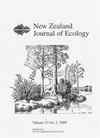开发一种新的大鼠控制复位工具
IF 1.4
3区 环境科学与生态学
Q3 ECOLOGY
引用次数: 0
摘要
:一种重置毒素的装置(“喷火式”)已经被设计出来,当老鼠穿过隧道时,它会将有毒的糊状物输送到老鼠的腹面。老鼠洗去糊状物并摄入毒素。该系统在笼内试验和一次现场试验中进行了评估。笼内试验的目的是调查喷火式战斗机是否可以将一系列毒素输送给大鼠(Rattus Rattus和R.norvegicus),即0.55%氟乙酸钠(1080)、0.2%溴二氟康、15%胆钙化醇和12.5%磷化锌。1080、溴二氟康和磷化锌的试验取得了成功,超过85%的大鼠摄入了致命剂量。胆钙化醇的试验不太成功,只有58%的大鼠死亡。在喷火战斗机上使用1080进行了为期一个月的试验。大鼠(和白鼬)的丰度下降,为这种毒素的喷火式发射系统提供了概念证明。对引入的大鼠进行长期有效的控制需要一系列具有不同作用模式的毒素。喷火式战斗机可能是老鼠的一种有用的额外控制工具,目前正在进行重新设计,使其更加可靠。本文章由计算机程序翻译,如有差异,请以英文原文为准。
Developing a new resetting tool for controlling rats
: A resetting toxin device (the “Spitfire”) has been designed that delivers a toxic paste to a rat’s ventral surface when it passes through a tunnel. The rat grooms off the paste and ingests the toxin. The system was assessed in cage trials and one field trial. The purpose of the cage trials was to investigate whether a range of toxins can be delivered by the Spitfire to rats ( Rattus rattus and R. norvegicus ), namely 0.55% sodium fluoroacetate (1080), 0.2% brodifacoum, 15% cholecalciferol, and 12.5% zinc phosphide. The trials with 1080, brodifacoum, and zinc phosphide were successful with > 85% of rats ingesting lethal doses. The trials with cholecalciferol were less successful with only 58% of rats dying. A one-month pilot field trial was undertaken using 1080 in the Spitfires. There was a knockdown in rat (and stoat Mustela erminea ) abundance, establishing proof of concept for the Spitfire delivery system with this toxin. The long-term, effective control of introduced rats will require a range of toxins with different modes of action. The Spitfire could be a useful additional control tool for rats and is currently being re-engineered to be made more reliable.
求助全文
通过发布文献求助,成功后即可免费获取论文全文。
去求助
来源期刊

New Zealand Journal of Ecology
环境科学-生态学
CiteScore
3.00
自引率
12.50%
发文量
35
审稿时长
>36 weeks
期刊介绍:
The New Zealand Journal of Ecology is a biannual peer-reviewed journal publishing ecological research relevant to New Zealand/Aotearoa and the South Pacific. It has been published since 1952 (as a 1952 issue of New Zealand Science Review and as the Proceedings of the New Zealand Ecological Society until 1977). The Journal is published by the New Zealand Ecological Society (Inc.), and is covered by Current Contents/Agriculture, Biology and Environmental Science, GEOBASE, and Geo Abstracts.
 求助内容:
求助内容: 应助结果提醒方式:
应助结果提醒方式:


